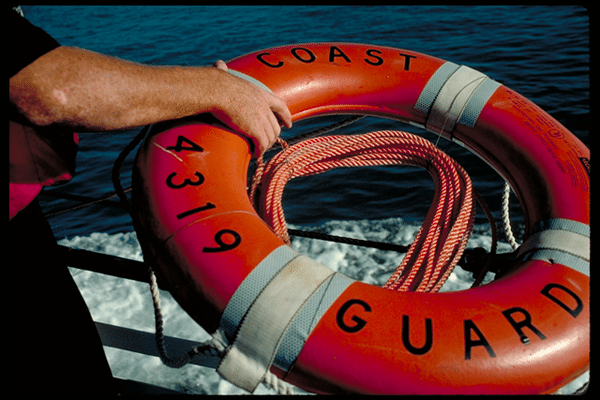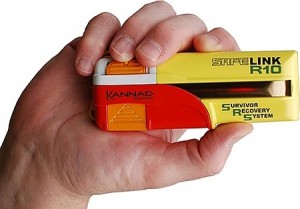Was The World’s ‘Northern-Most Island’ Erased From Charts?
by Kevin Hamilton (University of Hawaii) In 2021, an expedition off the icy northern Greenland coast spotted what appeared to be a previously uncharted island. It was small and gravelly,...




Fire, sinking, and even collisions can turn an ordinary day at sea into a flutter of activity and worry, but nothing provokes the immediate and raw emotions as the two simple words, “Man Overboard.” No matter how remote the chances of it occurring aboard your ship, no sailor has ever set to sea without the thought of drifting alone at sea after falling overboard.
Fortunately, many of the myths of man overboard (MOB) recovery, including hypothermia and drowning, have been debunked and new ISM and IMO safety procedures have reduced the occurrence of MOBs.
One truth will always remain…
If the man overboard is not found, he or she will not be recovered.
New devices exist to increase the chance of recovery. First up AIS SARTS:
AIS SART


I have long been a proponent of Personal Locator Beacons (PLB), the handheld sized versions of EPIRB’s, and I have even gone as far as saying “that one of these devices should be required inside every lifeboat and liferaft that goes to sea“. I also believe, due to their diminutive size, these devices belong clipped onto the lifejackets of all persons who go on deck in rough weather.
But, as great as they are, EPIRBS are a global positioning system.
They are excellent at notifying the Coast Guard of your location, but are poor in helping nearby vessels track MOB victims. In the past, we have suggested throwing both the EPIRB (you do have more than one aboard, right!?) and SART overboard to help track a victim’s progress through the water, this way you have both global (EPIRB) and local (SART) tracking abilities.
Wouldn’t it be better if you could identify the exact location of a Man Overboard?
EasyRescue, a portable AIS SART that’s small enough to clip to your belt. The manufacturer, the german based company EasyAIS, tells us:
The Easy Rescue is a personal Automatic Identification System transmitting beacon. With a built in GPS it transmits an emergency AIS-SART sentence (MOB) which triggers an alarm on all AIS enabled chart plotters / PC’s within range, along with the Lat/Long of the victim. The GPS is a new generation fast acquiring type and the VHF AIS transmitter repeats the message and position several times per minute. This enables all vessels within range to assist with the rescue if they have an AIS receiver or transponder.
Apart for an AIS receiver or transceiver connected to a chart plotter / PC, nothing. The Easy Rescue maybe attached to a life jacket or kept on a lanyard. To operate just slide the safety cover off (releasing the coiled antenna) and press ON. A test button allows regular test of GPS function, battery state etc. Continue Reading…


Another company, Kannad Marine, has taken the concept a step further with the release of the new SafeLink R10 SRS (Survivor Recovery System), a small AIS SART which can be packed into inflatable lifejakcets. Clipping onto the inflation tube (or just secured to the front of a traditional PFD) the unit automatically activates when the vest is inflated. The SafeLink R10 transmits target survivor information, including structured alert messages, GPS position information, and a unique serialised identity number back to the onboard plotter*. An inbuilt high precision GPS receiver provides accurate position information to assist in quick recovery of survivors.It will transmit continuously for a minimum of 24 hours and has a 7 year battery storage life.
It also features a flashing LED indicator light; to aid detection at night and a self test facility with battery use indication. Here’s a video demonstrating it’s use:
I tested the EasyRescue a few months ago and was given a hands-on demonstration of the Safelink R10 at a recent conference. Both units are small and appear to be well built. The EasyRescue appears to be the perfect unit for mounting aboard FastRescue boats to track SAR patterns in an emergency or included inside the emergency kits of liferafts and lifeboats. While the Safelink, due to its size, seems perfect for individual (especially inflatable!) lifejackets.
But what happens once these devices are activated?
AIS SARTS are built similar to EPIRBS but they work on a local level. EPIRBS collect your position via GPS and send that information to a Rescue Coordination Center which organizes a rescue but they do not notify nearby ships – the same ships that are your best chance for getting rescued in a MOB situation – of your immediate distress. AIS SARTS also collect your coordinates via GPS but they take this information and (like older RADAR activated SART) broadcast it to all nearby ships.
Upon activation, all nearby ships, and boats equipped with AIS receivers, will be notified with messages popping up on their AIS device and connected ECDIS systems, and will get a range and bearing to your exact location which is updated, in real time, as you drift away from your ship.
The Drawbacks
Like any emerging technology the new AIS SART units aren’t perfect (yet). The biggest problem is, because they are so new, many ECDIS systems don’t properly recognize the alert as a distress. Many other ECDIS systems sound the same alarm signal for MOB as they do for high bilge levels and other nuisance alarms. But systems are being developed to fix this problem. The following video explains the problem and one solution being offered by marine electronics manufacturer Digital Yacht:
Another drawback is that some industry insiders claim there are better systems for locating MOB victims. As one example the excellent marine electronics boating blog Panbo discusses the future of DSC (Digital Selective Calling) MOB beacons for activating a ship’s GMDSS system in the event of a MOB. In an article titled “AIS & DSC MoB devices, the standards revealed” Panbo editor Ben Ellison writes:
The DSC MoB spec, for instance, allows for a much fuller featured device than what we saw with the ORCAdsc MOB Alarm back in 2010. An upgraded ORCAdsc could automatically go from “closed loop” mode — that is, only alarming the vessel or fleet it’s associated with — to “open loop” mode after five minutes in the drink. Then it would transmit “a standard all ships DSC distress alert with nature of distress ‘man overboard’ and GPS position automatically inserted…to all DSC equipped ships and shore stations in range (normally about 2 nm).” I don’t know that such a device exists yet but they will additionally include a VHF Channel 70 receiver so that the crewperson overboard will know that his or her alarm has been acknowledged and (I think) that also means that device will stop sending off alarms at that point. Sounds smart, but so does the AIS spec.
What do I carry?
While these units are available internationally, US mariners will have to wait on the approval of the FCC and, even overseas, Regulators and manufacturers are still studying AIS SART technology but I believe these tests, including a large field study being conducted by Kannad and a large pacific seafood company, will make it clear that every professional mariner should owe a personal AIS SART device. But until the units are available in the US and familiar to local Search and Rescue organizations the following is what I carry when sailing gCaptain’s test boat, a 43′ sailing yacht, in the waters of the Pacific:
What is the future?
While some believe that DSC based SARTS are the answer, I’ve seen too many false alarms broadcast over the system in recent years. I like the AIS SARTS a lot but I think the ultimate solution will be a hybrid of the existing systems and I believe that AIS will soon replace the 121.5 homing signal still present in most 406 epirbs.
But what I like most is a simple waterproof radio so I can talk to nearby ships from the water. So the perfect system for me would be a bluetooth handheld VHF with integrated AIS that I can clip to my lifevest. Here are the features I’d have in my ideal unit I would like to clip to my lifejacket:
I know I’m reaching for the moon here but I think your best chance of survival in poor conditions (especially if you are the captain of your own boat) is being able to actually talk with the surrounding boats.
Surrounding boats (especially commercial ones) are likely to ignore a DSC alert but will NOT ignore someone asking for help on Channel 16.
What is your ideal personal locating system?
Join the gCaptain Club for curated content, insider opinions, and vibrant community discussions.


Join the 105,925 members that receive our newsletter.
Have a news tip? Let us know.
Access exclusive insights, engage in vibrant discussions, and gain perspectives from our CEO.
Sign Up




Maritime and offshore news trusted by our 105,925 members delivered daily straight to your inbox.



Essential news coupled with the finest maritime content sourced from across the globe.
Sign Up